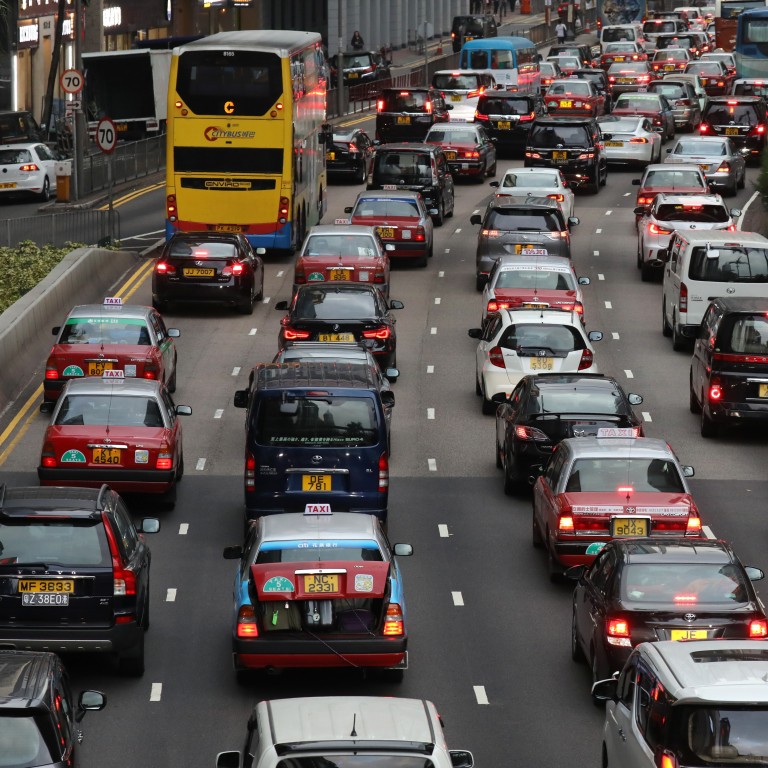
‘Smart’ technology could get cars off the roads in Hong Kong and into parking spaces faster
- Drivers cruising around to find parking spaces adds to Hong Kong’s traffic problem
- Robots, ‘smart’ Apps could help drivers get their vehicles off the streets quickly
Automobiles are one of the major means of transport in Hong Kong, but they are in use for just 3 per cent to 5 per cent of their lifetime, remaining parked for the rest of the time.
Given the scarcity of land, parking spaces are not easy to find, and looking for one is time-consuming.
According to Transport Department, the number of private cars in Hong Kong has soared from 402,000 in 2006 to 618,000 in 2018.
The number of vehicles is outnumbering parking spaces, resulting in illegal parking on the streets.
Cruising for parking is a problem caused by the increase of car owners, and additional traffic is then results from drivers wandering around in search of car parking spaces. Even though the government has implemented fierce tax policies on the prices of fuels and cars, the number of cars in Hong Kong continues to grow.
That raises the question: Do we need to have more parking spaces and better management?
The government is studying the feasibility of setting up a so-called “smart” car parking system with 200 parking slots at the junction between Yen Chow Street and Tung Chau Street in Sham Shui Po. In Kowloon East, under the core concept of “Smart City”, the Transport Department proposed to deploy a cylinder-vertical-lifting technology to park cars into empty spaces via a lift.
To support the Hong Kong government’s ambition to mould Hong Kong into a “Smart City”, Hong Kong Applied Science and Technology Research Institute (ASTRI) worked with the Energising Kowloon East Office (EKEO) to launch smart parking and a “Smart Parking” mobile app in January 2017. The technology is feasible for the site in Sham Shui Po, which is around 3,400 square metres in area without any superstructures on the ground.
Such technology can save drivers’ time in parking and collecting their cars, as well as alleviating the problem of illegal parking – one of the main causes of severe congestion. The Smart Parking pilot involves a cloud-based server that collects real-time parking vacancy data and an analysis function that finds the shortest driving route based on real-time traffic conditions.
Driven by the urban technology initiative, the German automobile manufacturer Audi aspires to set the concept of self-parking into motion.
The idea would help soothe traffic congestion as drivers could drop off their car in front of the car park without queuing. This revolutionary idea can be applied to city centres in Hong Kong.
For example, roads in Tsim Sha Tsui are mostly narrow and of single-lane dual way, resulting in on-street queuing, which prompts further congestion.
If an automatic car park is available in the Tsim Sha Tsui area, drivers can simply leave their cars at the entrance to allow the robots to park their cars. Similarly, drivers can pick their cars within a short time to reduce the waiting time of other drivers.
China has also made headway towards smart parking. In Hangzhou, a three-storey automated car park was built underneath a shopping centre. Being situated in the central business district, the car park has made use of a total of 500 robot dollies that support double parking to accommodate more vehicles at the same time. In tandem with the evolving technologies, self-checkouts via the scanning of QR codes are also incorporated to further speed up and streamline the process.
In terms of construction, the automated parking system has higher flexibility of installation, without the need to use large equipment. Thanks to the beauty of the underground construction process, the physical intervention exerted on the neighbourhood is mitigated. Moreover, the new car park is likely to be more economically friendly than typical car parks due to reduced excavation area by half, lowering construction cost by 30 per cent to 40 per cent.
Both being so-called “tiger cities”, Singapore and Hong Kong are often compared in their city advancement. The Singapore Sports Hub master plan exemplifies how sports, leisure and lifestyle destinations can be successfully developed in the city centre that creates a sense of place. Witnessing the successful development of sports excellence and the creation of active centres for Singaporeans, the Hong Kong government proposes to embody a dynamic range of facilities throughout the sites above the car parks, for instance, gardens, leisure areas with benches, shelters, playgrounds, gymnasiums, and lockers. This is to offer a place for diversified activities in a self-contained community that advances every individual’s experience.
After all, the government could consider implementing a large-scale development of smart car parking to replace low-storey car parks to efficiently utilise the land and free up land resources for other uses. Overall, the government should take an active role in evolving towards a “Smart City” and improving services offered to the people.
Chiu Kam-kuen is an international director and chief executive of Cushman & Wakefield Greater China

